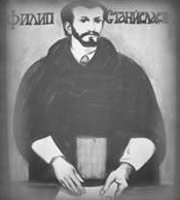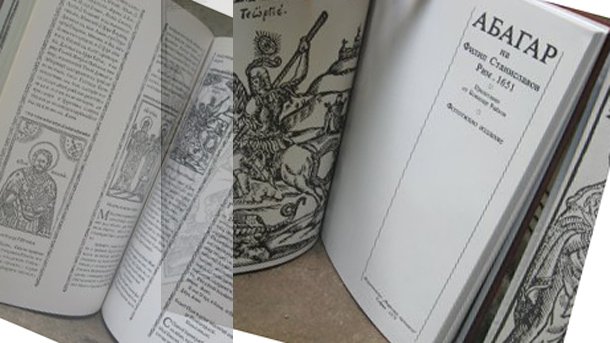
"Abagar" was the first printed book with elements of the modern Bulgarian language. It was printed in Rome on May 6, 1651 by the Bulgarian Catholic Bishop Philip Stanislavov. He was born around 1612 in an influential Paulician family in the village of Oresh near Svishtov. Paulicians were a heretical Christian religious movement preaching that the material world was a product of evil and the spiritual world was the realm of the good. It was among the Paulicians that the Roman Curia found fertile ground to spread the Catholic faith. With much persistence, the missionaries, mostly Franciscan monks, were able to attract them to the western church.
In 1622, at the time of Pope Gregory XV, the Vatican founded a Congregation for spreading the faith. One of its tasks was to establish special colleges in Rome, Bologna and prepare bright young people from other nations would be trained for teachers and missionaries in their native lands. One of these schools was the Slavic College in Loreto. In the 17th century, many young Bulgarian Catholics studied there, mostly from the region of Chiprovtsi and Nikopol.
They travelled a long way from the Bulgarian lands to Loreto, but every year the Congregation paid the expenses for six Bulgarian boys. One of them was Philip Stanislavov who was sent there by the Franciscan Fathers. From 1627 until 1633, he was at the so-called Illyrian College where he studied theology, history, geography, as well as Italian and Latin. The training in the school was done in the Croatian language, but Philip Stanislavov also spoke Turkish, Tartar and Wallachian. He was ordained a priest in the city of Ancona. From 1633 to 1635, Philip Stanislavov was in Rome - in the Papal Curia where he was appointed official interpreter of Pope Urban VIII from Slavic and other languages. Then he returned to his native place at the request of Bishop Ilia Malinov. Highly educated in the western model and with a very strong national feeling in his heart, he cares for the enlightenment of his countrymen. He was also educating more than 20 children, some of them were sent to study in Italy.
In August 1648, the Congregation for the Propagation of the Faith appointed Philip Stanislavov bishop of the Catholic Diocese of Nikopol in north central Bulgaria. For many years, he lived in the village of Tranchovitsa near Pleven. There he built a very nice school with a diverse curriculum that prepared candidates for priesthood. The Congregation for the Propagation of the Faith taught missionaries to apply deep insight in their actions and required them to have a fair knowledge of Slavic languages. The church service was conducted in Latin but some books were read in Slavonic. The sermons were held in the everyday Bulgarian language that ordinary people spoke, which was gradually replacing the textbooks written in Bosnian-Croatian.
Bishop Philip Stanislavov was very popular because of his democratic behavior and ability to adapt to this difficult and arduous lifestyle. He continued to work tirelessly for the spiritual elevation of his countrymen. He saught help everywhere and when his entreaties resulted in nothing, he erected temples of prayer with his own work and his own money.

© Photo: archive
Perhaps his desire to see Bulgarians more educated made Philip Stanislavov prepare and print in Rome on May 6, 1651, a collection of prayers entitled "Abagar". The book was published in Cyrillic on one side of the page only - on five large sheets with a width of 44.5 cm and hight of 33.5 cm. The paper was Italian, thin but rough. In their bottom part, the sheets were numbered with Cyrillic letter digits. On each sheet the text is printed in four narrow columns, each of which is surrounded by a frame of ornaments, so if the columns are cut and lined up consistently, thus a line would be obtained about 5.80 meters long. Thus, the collection can be shaped like a scroll and worn as an amulet. The only preserved specimen of this type is located in the Bologna library.
This ability to carry the book as a mascot explains its name. It contains an apocryphal story about the message of the Ephesus King Abagar to Jesus, but the word abagar was also used to denote the special amulets that the Paulicians carried to protect themselves from evil forces. Indeed, the book is a collection of prayers whose language is close to that of the modern Bulgarian homilies that appeared in the same period. Its content was taken from the apocryphal and canonical literature.
The book is printed in the Bosnian Cyrillic script and according to many scholars its language is characterized by Church-Slavonic, Serbo-Croatian and new Bulgarian elements imported from the literary sources that Philip Stanislavov had available at the time. “Abagar” also has engravings which depict various saints and are characterized by the simplified and stylized form of Italian engraving.
In general, Abagar was a collection that was supposed to serve the needs of Catholic propaganda, but Bishop Stanislavov adapted it for Bulgarian society, for this reason it is written in a language understandable to ordinary Bulgarians. The book was an expression of his concern for the education and spiritual enlightenment of the Bulgarian people. The Bulgarian identity took prevalence inside him and he proved this in his subsequent life. The collection became popular among Bulgarians, and Philip Stanislavov continued his educational and missinary activities, traveling not only across his diocese but across many other places, as well.
As the author of the first printed book with elements of modern Bulgarian, Philip Stanislavov donated it to his people for the benefit of the Bulgarian nation. Being the bearer of high intellectual culture, he wanted to share it with ordinary Bulgarians. His activity was not restricted to the tenets of religion alone. It is educational, cultural, and patriotic. Today copies of Abagar are kept in the libraries of Rome, Vienna, Paris, Copenhagen, Brussels, Odessa, Moscow, Sofia and Leipzig.
Two centuries before the liberation of Bulgaria from five centuries of Ottoman rule, at the end of the book Stanislavov wrote: "Just as the bee is gathering wax and honey from different fragrant flowers, in the same way Philip Stanislavov, bishop of Greater Bulgaria, collected and compiled from various books of the Holy Fathers his own collected called Abagar and gave it to the Bulgarian people to use it as if it were powerful relics of a saint. This Abagar was printed in 1651 on 6 May in the Eternal City, where the bodies of Peter and Paul are buried."
English version Rossitsa Petcova
Nearly 40 years ago, the Bulgarian Orthodox Church Communities (BOCC) in Western and Central Europe were concentrated in several cities. After our country joined the European Union and with the growth of the Bulgarian diaspora, the Bulgarian church..
The Feast of the Annunciation is the day when God's promise for the salvation of the human soul from the eternal torments of darkness is fulfilled. Its message is that God loves us, says Father Bozhidar Marinov from the "Exaltation of the Holy Cross..
Veliko Tarnovo is proud of its glorious past, encoded in the city’s holiday, associated with the day of the Holy Forty Martyrs – the spiritual patrons of Bulgaria's medieval capital. On the day of the 40 followers of Christ (March 22 according to..

+359 2 9336 661
